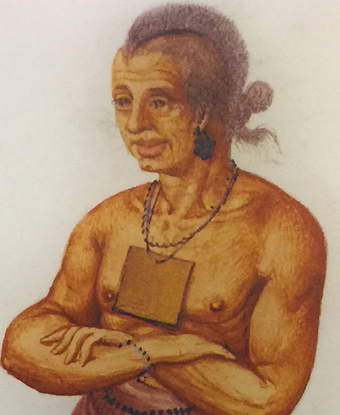Last updated: August 13, 2025
Person
Wingina

National Park Service
Wingina was a werowance (chief) of the Algonquian people of Ossomocomuck (Outer Banks) in the 1580s. His initial support of the English presence in the Outer Banks waned as many of his people died from disease. Before he could rally people to help fight against the English colonization, he was attacked and killed by the English, becoming one of the first Algonquian casualties at the hands of the English during their colonization of North America.
Born in the 1500s in Ossomocomuck, Wingina rose to power by the 1580s to be the leading werowance over the Roanoke, Secotan, and Croatoan people of the Outer Banks. Either through force or diplomacy, he consolidated control of many villages scattered throughout the area by 1584, controlling a large portion of the area. Shortly before English explorers arrived in the area, he had been injured in a battle and was unable to travel to Roanoke Island to meet them. Instead, he communicated through his brother, Granganimeo, to send two Algonquian men, Manteo and Wanchese, with the English when they left.
When the English returned in 1585, Wingina sent Granganimeo to meet with the English and allowed them to build a fort on the northern end of Roanoke Island, near the Algonquian village. Wingina likely wanted to keep the English close to his people to allow them to trade and learn from them. While the English are at Roanoke Island, Wingina gets pulled in different directions by some of his people. Granganimeo and Manteo served as staunch believers and supporters of the English, while Wanchese was a consistent voice opposing the English. As leader, Wingina works to try and understand the English intentions and if they will benefit his people. Wingina was painted by John White during the summer of 1585 becoming one of the first Algonquian people depicted by a European artist.
As winter turned to spring, Granganimeo, and a father-figure for Wingina, Ensenore, died from disease. With two of the strong English supporters gone, Wingina began to doubt the good intentions of the English in the area. Shortly after Granganimeo died, Wingina decided to change his name to Pemisapan, which roughly translates as "The one who watches." Pemisapan pulled back trade with the English supplying less food to them to support his own people as they battled diseases.
In the spring, the English are told by Pemisapan that one of the enemies of the Roanoke, the Chowanoke people, led by Menatonan, up the Albemarle Sound, were preparing to launch an attack against the English. He told them they were gathering their forces near the Chowan River. The English moved west up the Albemarle Sound to confront Menatonan, but when they arrived, they heard a different story. Menatonan told the English they were deceived, and it was Pemisapan who was gathering forces to strike at the English. Unsure who to trust, they took Menatonan's son hostage and returned to Roanoke Island.
Whether it was Menatonan or Pemisapan who prepared to attack the English is up for debate, but the leader of the English colony, Ralph Lane, decided Pemisapan was an enemy of the English. At the end of spring in 1586, Pemisapan saw Ralph Lane, Manteo, and many other Englishmen land on their shores and enter the village. Ralph Lane shouted, "Christ, Our Victory!" and the Englishmen began firing on the Roanoke people, wounding Pemisapan. After he was shot, he fell to the ground and waited for the moment to get to safety. When the fighting slowed, he got up and ran into the woods, but his injury slowed his escape, and he was chased down by an Irishman named Edward Nugent. Upon his capture, Pemisapan was beheaded by Edward Nugent.
Pemisapan's murder was not just a murder of a single person, but a symbolic murder of the relationship between the Roanoke people and the English. Just one week after his murder, the English left Roanoke Island, abandoning their colony. One year later, when the Lost Colony arrives on Roanoke Island, it is believed that the murder of George Howe was revenge by the Roanoke people for the murder of Pemisapan.
